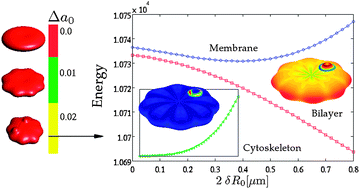Elastic energies and morphologies of the first stages of the discoechinocyte transition
Abstract
Red blood cells are highly sensitive to changes in the relative areas of the two

* Corresponding authors
a
Departament d'Estructura i Constituents de la materia, Universitat de Barcelona, Av. Diagonal 647, E08028 Barcelona, Spain
E-mail:
lazaro@ecm.ub.es
b CIC biomaGUNE, Paseo Miramon 182, 20009 San Sebastian, Spain
c Institute for Biophysics, Department of Nanobiotechnology, University of Natural Resources and Life Sciences Vienna (BOKU), Muthgasse 11, 1190 Vienna, Austria
d Departament de Fisica Fonamental, Universitat de Barcelona, Av. Diagonal 647, E08028 Barcelona, Spain
Red blood cells are highly sensitive to changes in the relative areas of the two

 Please wait while we load your content...
Something went wrong. Try again?
Please wait while we load your content...
Something went wrong. Try again?
G. R. Lázaro, K. A. Melzak, J. L. Toca-Herrera, I. Pagonabarraga and A. Hernández-Machado, Soft Matter, 2013, 9, 6430 DOI: 10.1039/C3SM50716E
To request permission to reproduce material from this article, please go to the Copyright Clearance Center request page.
If you are an author contributing to an RSC publication, you do not need to request permission provided correct acknowledgement is given.
If you are the author of this article, you do not need to request permission to reproduce figures and diagrams provided correct acknowledgement is given. If you want to reproduce the whole article in a third-party publication (excluding your thesis/dissertation for which permission is not required) please go to the Copyright Clearance Center request page.
Read more about how to correctly acknowledge RSC content.
 Fetching data from CrossRef.
Fetching data from CrossRef.
This may take some time to load.
Loading related content
